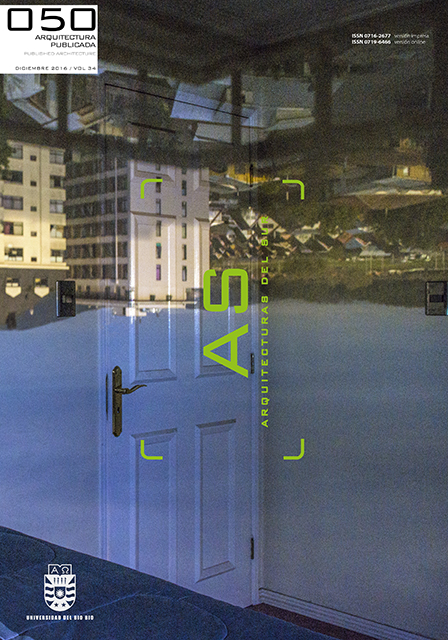From urban planning to planning: pastor in la revista de arquitectura (1943-1951)
DOI:
https://doi.org/10.22320/07196466.2016.34.050.05Keywords:
architecture, social housing., urban planning, planning, journals, social housingAbstract
Urban planning as a discipline was consolidated in Argentina in the first half of the twentieth century. It was institutio- nalized in academia through the establishment of courses of undergraduate and graduate study and through research institutes. At the same time this process was taking place, urban planning succeeded in inserting itself into the state bureaucracy, thereby gaining a greater ability to operate in the city. Its development as a theoretical discipline and specific public policy occurred during the middle of the last century under the name “planning”. Discussions within the state structure, academia, professional associations and the public sphere found a discursive node in the Revista de Arquitectura de la Sociedad Central de Arquitectos (Architectural Journal of the Central Society of Architects). Within this source, in the decade of the 1940s the architect José Manuel Felipe Pastor stands out as a planning theorist and for his use of English and American urban planning theory. This article explores how the discourse that updated urban planning was constructed through Pastor ́s writings in Revista de Arquitectura.
Downloads
References
BRUNO, Paula. Paul Groussac. Un articulador cultural en el pasaje del siglo XIX al XX argentino. Araucaria, Revista Iberoamericana de Filosofía, Política y Humanidades, 2006, n°8, pp. 176-186.
CIRVINI, Silvia Augusta. Las revistas técnicas y de ar- quitectura (1880-1945). Periodismo especializado y modernización en Argentina. Argos, 2011, n°54, vol. 28, pp. 13-60.
Divulgación del urbanismo y la arquitectura. Revista de Arquitectura, octubre de 1949, año 34, n°346, pp. CCXC- VII.
GENTILE, Eduardo. Revista de Arquitectura. En: Liernur, Jorge Francisco y Aliata, Francisco (comps.). Diccionario de arquitectura en la Argentina: estilos, obras, biografías, instituciones, ciudades. Buenos Aires: AGEA, 2004, pp. 175-178.
GORELIK, Adrián. Pastor, José M. F. En: Liernur, Jorge Francisco y Aliata, Francisco (comps.). Diccionario de ar- quitectura en la Argentina: estilos, obras, biografías, insti- tuciones, ciudades. Buenos Aires: AGEA, 2004, pp. 46-48.
GUTIÉRREZ, Ramón. Sociedad Central de Arquitectos. 100 años de compromiso con el país 1886/1986. Buenos Aires: SCA, 1993.
MAZZA, Carlos Jerónimo y BRUNO, Peralta Ana. Políticas públicas para la organización del territorio en la provincia de Buenos Aires en la gobernación de Domingo Mercante. Ponencia presentada en el Primer Congreso de Estudios sobre el Peronismo: La Primera Década, Mar del Plata, 2008.
NOVICK, Alicia y PICCIONI, Raúl. Carlos María Della Paolera o la Amnesia del Urbanismo Argentino. Anales del Instituto de Arte Americano e Investigaciones Estéticas “Mario J. Buschiazzo”, 1998, n°30, pp. 112-149.
PASTOR, José Manuel Felipe. El pasado, la arquitectura y el futuro. Revista de Arquitectura, enero 1944, año 29, n° 277, pp. 20-21.
PASTOR, José Manuel Felipe y PRATS, Roque. Centro ju- venil de recreación. Revista de Arquitectura, enero 1944, año 29, n° 277, pp. 36-43.
PASTOR, José Manuel Felipe. San Juan. Piedra de toque del planeamiento nacional. Primera edición. Buenos Ai- res: Editorial Arte y Técnica, 1945.
PASTOR, José Manuel Felipe. Urbanismo con planea- miento. Principio de una nueva técnica social. Buenos Aires: Editorial Arte y Técnica, 1947.
PASTOR, José Manuel Felipe. Curso básico de planea- miento urbano y rural. Buenos Aires: Ministerio de Obras Públicas. Provincia de Buenos Aires, 1950.
PASTOR, José Manuel Felipe. TVA. Planificación del Valle del Tennesse. Buenos Aires: Contempora, 1951.
Revista de Arquitectura cumple 25 años. Revista de Ar- quitectura, julio 1940, año 26, n° 235, pp. 193-194.
RIGOTTI, Ana María. Las invenciones del urbanismo en Argentina (1900-1960). Rosario: UNR Editora, 2014.
Una posta. Revista de Arquitectura, febrero 1943, año 28, n° 266, pp. 45-48.
Downloads
Published
How to Cite
Issue
Section
License
Copyright (c) 2016 Juan José Gutierrez

This work is licensed under a Creative Commons Attribution-ShareAlike 4.0 International License.
The content of the articles published in each issue of Arquitecturas del Sur is the sole responsibility of the authors and does not necessarily represent the opinion of University of the Bío-Bío.
The authors will maintain their copyright; however, they will guarantee the journal the right to first publication and dissemination of their work. The publication of the article in Arquitecturas del Sur will be subject to the Creative Commons International license (CC BY-SA) that allows others to adapt: remix, transform and build on the material for any purpose, even commercially; share: copy and redistribute the material in any medium or format, as long as the authorship and first publication in this journal are acknowledged by citing them correctly, and their new contributions are under a license with the same terms.














 Programa de Información Científica/Concurso Fondos de Publicación de Revistas Científicas 2018/ Proyecto Mejoramiento de Visibilidad de Revistas UBB (Código:FP180007)
Programa de Información Científica/Concurso Fondos de Publicación de Revistas Científicas 2018/ Proyecto Mejoramiento de Visibilidad de Revistas UBB (Código:FP180007) 
